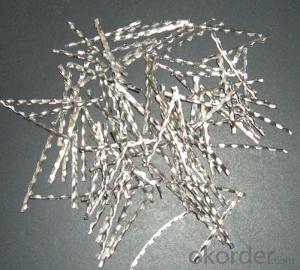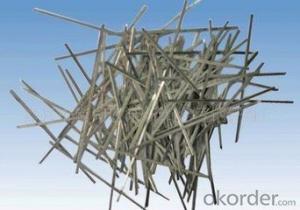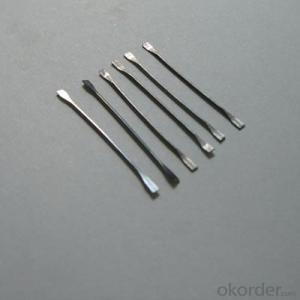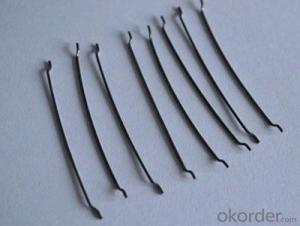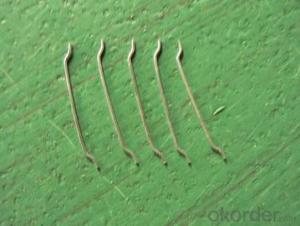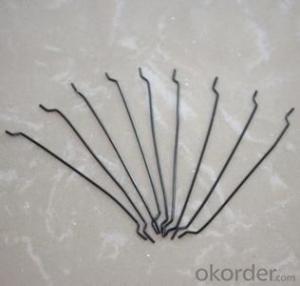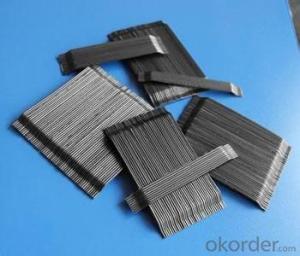Steel Fiber Loose CNBM International Corperation
- Loading Port:
- Tianjin
- Payment Terms:
- TT OR LC
- Min Order Qty:
- 2000 kg
- Supply Capability:
- 30000 kg/month
OKorder Service Pledge
OKorder Financial Service
You Might Also Like
Quick Details
Place of Origin: Jiangsu, China (Mainland)
Model Number: HT-MC
Material: Color Steel
certificated: ISO 9001
Specifications
ISO 9001 certificated
2.70% for Europe, Middle Asia, America market
3.Have the most number of steel fiber machine in china
1. Material: low carbon steel wire or stainless steel
2.Diameter: 0.4mm-1.0mm
3.Length: meet your requirements
4.tensile strength >1000Mpa
6.Feature: excellent tensile,high tenacity,against cracking,impact and fatigue
7.Uses: highway road surface,tunnel,building,airport road surface and so on .
Straight Steel Fiber
1.ISO 9001 certificated
2.70% for Europe, Middle Asia, America market
3.Have the most number of steel fiber machine in china
Picture

Steel fiber
FAQ
certificated: ISO 9001
Technical advantages of Daye steel fiber:
A. Improve mechanical performance of concrete
B. Provide uniform distribution throughout concrete with excellent mixing
C. No balling or caking by adopt correct mixing method
D. Reduce concrete volume
E.Save construction time and cost
F.Reduce excavation volume
G.Available for jointless floor.
- Q:How does the addition of melt extract stainless steel fiber affect the ductility of concrete?
- The addition of melt extract stainless steel fiber generally improves the ductility of concrete. Stainless steel fibers act as reinforcements within the concrete matrix, enhancing its ability to withstand tensile stresses. This results in a higher ductility, allowing the concrete to undergo more deformation before failure.
- Q:Does melt extract stainless steel fiber have a high resistance to corrosion?
- Yes, melt extract stainless steel fiber has a high resistance to corrosion.
- Q:Is melt extract stainless steel fiber compatible with all types of concrete curing methods?
- No, melt extract stainless steel fiber is not compatible with all types of concrete curing methods. While stainless steel fibers can enhance the mechanical properties of concrete, their effectiveness may vary depending on the curing method used. For example, if the concrete is subjected to high-temperature curing methods such as steam curing or autoclaving, the melt extract stainless steel fibers may experience a reduction in their mechanical properties due to the high heat. This can lead to a decrease in the overall performance of the concrete. On the other hand, if the concrete is cured using traditional methods such as air curing or water curing, the melt extract stainless steel fibers can be compatible and provide beneficial reinforcement to the concrete. These fibers can improve the tensile strength, crack resistance, and durability of the concrete, leading to enhanced performance and longevity. It is important to consider the specific curing method and its impact on the melt extract stainless steel fibers when using them in concrete applications. Consulting with experts and conducting proper testing can help determine the compatibility and effectiveness of these fibers in different curing methods.
- Q:Can melt extract stainless steel fiber be used in high-temperature environments?
- Yes, melt extract stainless steel fiber can be used in high-temperature environments. Stainless steel is known for its excellent heat resistance properties, making it suitable for applications where high temperatures are involved. Melt extract stainless steel fibers are typically made from a high-grade stainless steel alloy, which provides enhanced resistance to oxidation and corrosion at elevated temperatures. These fibers can withstand temperatures up to 1200°C (2192°F) without losing their structural integrity. Therefore, they are commonly used in industries such as aerospace, automotive, and refractories, where high-temperature environments are prevalent.
- Q:How does melt extract stainless steel fiber improve impact resistance in concrete?
- The impact resistance of concrete is enhanced by melt extract stainless steel fiber, as it reinforces the concrete and improves its structural integrity. During the mixing process, the fibers are dispersed throughout the concrete matrix, creating a reinforcement system in the form of a three-dimensional network. When a load or impact is applied to the concrete, the stainless steel fibers help distribute the stress and absorb the energy. This action prevents cracks from propagating and reduces the chances of concrete failure. The fibers function as miniature reinforcement bars, enhancing the concrete's tensile strength and ductility. Additionally, the melt extract stainless steel fibers have a high aspect ratio, which means they are long and thin. This attribute further enhances their effectiveness in impact resistance. The fibers can bridge and connect cracks in the concrete, inhibiting their growth and preventing further damage. The impact resistance properties of the stainless steel fibers are also attributed to the stainless steel material itself. Stainless steel is renowned for its strength and durability, making it an excellent choice for reinforcing concrete. It also has exceptional corrosion resistance, ensuring the long-term performance and durability of the concrete structure. In summary, melt extract stainless steel fiber improves the impact resistance of concrete by providing additional reinforcement, distributing stress, absorbing energy, preventing crack propagation, enhancing tensile strength, and bridging cracks. Its high aspect ratio and corrosion-resistant properties further contribute to its effectiveness in enhancing the overall impact resistance of concrete structures.
- Q:How does melt extract stainless steel fiber improve the resistance of concrete to chloride ingress?
- The utilization of melt extract stainless steel fiber is essential in enhancing the concrete's resistance against chloride infiltration. When incorporated into the concrete mixture, these stainless steel fibers create a physical barrier that hampers the movement of chloride ions into the concrete matrix. Chloride ions are a primary factor in the corrosion of reinforced concrete structures. They infiltrate the concrete and reach the steel reinforcement, resulting in corrosion and eventual deterioration. This not only compromises the concrete's structural integrity but also diminishes its lifespan. By introducing melt extract stainless steel fibers into the concrete, the permeability of the material is effectively reduced, thereby limiting the entry of chloride ions. These fibers establish a network within the concrete, forming a three-dimensional reinforcement system that restricts the movement of chloride ions. Additionally, the stainless steel fibers enhance the concrete's mechanical properties, rendering it more resistant to cracking and spalling caused by chloride-induced corrosion. They improve the concrete's tensile and flexural strength, minimizing the potential formation and propagation of cracks. Moreover, melt extract stainless steel fibers serve as sacrificial anodes, preventing the corrosion of the steel reinforcement. As the chloride ions come into contact with the stainless steel fibers, they are attracted to the fibers instead of the reinforcement, thereby reducing the risk of corrosion. In conclusion, melt extract stainless steel fibers enhance the concrete's resistance to chloride infiltration by establishing a physical barrier, reducing permeability, improving mechanical properties, and acting as sacrificial anodes. These fibers significantly prolong the lifespan of concrete structures by mitigating the detrimental effects of chloride-induced corrosion.
- Q:How does melt extract stainless steel fiber improve the fire resistance of concrete?
- Melt extract stainless steel fiber improves the fire resistance of concrete by enhancing its ability to withstand high temperatures. The steel fibers act as reinforcements within the concrete matrix, increasing its overall strength and preventing cracks and spalling under thermal stress. This enhances the structural integrity of the concrete, allowing it to retain its strength and shape even when exposed to extreme heat. Additionally, the stainless steel fibers help to dissipate heat more effectively, reducing the risk of thermal shock and further enhancing the fire resistance of the concrete.
- Q:How does melt extract stainless steel fiber improve the crack resistance of concrete?
- Melt extract stainless steel fiber improves the crack resistance of concrete by reinforcing the material and enhancing its tensile strength. The fibers act as a network within the concrete, distributing the stress and preventing the formation and propagation of cracks. This reinforcement also helps to improve the overall durability and lifespan of the concrete structure.
- Q:What is the thermal conductivity of melt extract stainless steel fiber?
- The thermal conductivity of melt extract stainless steel fiber may vary depending on different factors, including the composition of the stainless steel alloy, the manufacturing process, and the specific application. However, stainless steel is generally recognized for its relatively low thermal conductivity when compared to other metals. Stainless steel fibers are commonly utilized as reinforcement in various composite materials, such as high-temperature insulation, concrete, and plastics. These fibers can enhance the mechanical properties and thermal stability of the composites. Regarding thermal conductivity, stainless steel fibers offer a moderate level of heat transfer resistance. Although they are not as efficient as insulating materials like ceramics or polymers, stainless steel fibers still exhibit better thermal conductivity compared to solid stainless steel. This is due to the smaller cross-sectional area of the fibers, which reduces the direct conduction of heat. It should be noted that the thermal conductivity of melt extract stainless steel fiber can be additionally influenced by factors such as fiber diameter, aspect ratio, packing density, and temperature. Consequently, it is essential to consider these variables when assessing the thermal conductivity of stainless steel fiber in a particular application.
- Q:How does melt extract stainless steel fiber affect the ductility of shotcrete?
- The ductility of shotcrete is significantly influenced by the inclusion of melt extract stainless steel fiber. Ductility refers to a material's capability to undergo deformation without fracturing or breaking. When melt extract stainless steel fibers are introduced into shotcrete, they enhance the overall ductility of the substance. The addition of stainless steel fibers boosts the tensile strength of shotcrete, rendering it more resistant to cracking when subjected to tensile stress. These fibers act as reinforcement within the shotcrete matrix, offering additional support and improving the substance's ability to withstand external forces. With the inclusion of melt extract stainless steel fibers, shotcrete experiences increased ductility, allowing it to better accommodate any structural movement or settlement. This is especially crucial in situations where shotcrete is exposed to dynamic loading or ground movements, such as in tunnels or underground structures. Moreover, the improved ductility of shotcrete resulting from the integration of stainless steel fibers also enhances its durability. The fibers aid in the distribution and dissipation of applied loads or stresses more evenly throughout the substance, preventing localized cracking or failure. In summary, the integration of melt extract stainless steel fiber into shotcrete has a positive impact on its ductility by enhancing its tensile strength, increasing its resistance to cracking, and improving its ability to withstand external forces. This makes shotcrete more reliable and suitable for various construction applications, providing enhanced structural performance and longevity.
1. Manufacturer Overview |
|
|---|---|
| Location | |
| Year Established | |
| Annual Output Value | |
| Main Markets | |
| Company Certifications | |
2. Manufacturer Certificates |
|
|---|---|
| a) Certification Name | |
| Range | |
| Reference | |
| Validity Period | |
3. Manufacturer Capability |
|
|---|---|
| a)Trade Capacity | |
| Nearest Port | |
| Export Percentage | |
| No.of Employees in Trade Department | |
| Language Spoken: | |
| b)Factory Information | |
| Factory Size: | |
| No. of Production Lines | |
| Contract Manufacturing | |
| Product Price Range | |
Send your message to us
Steel Fiber Loose CNBM International Corperation
- Loading Port:
- Tianjin
- Payment Terms:
- TT OR LC
- Min Order Qty:
- 2000 kg
- Supply Capability:
- 30000 kg/month
OKorder Service Pledge
OKorder Financial Service
Similar products
New products
Hot products
Related keywords






